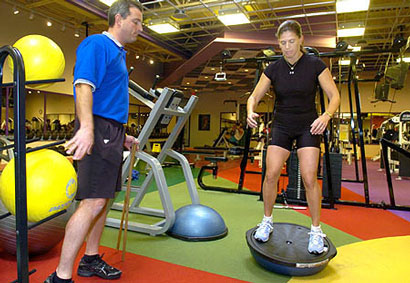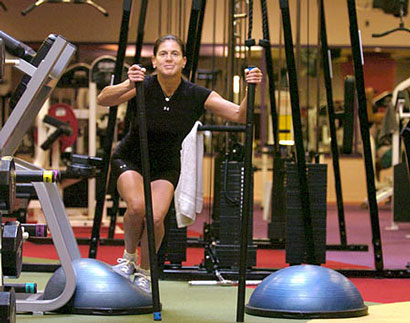
Personal trainer Eric Lugg works on balance exercises with Tracy Levy, who's planning a ski trip with her family later this winter. (Darrell Sapp, Post-Gazette)
. ski analyses : Is your body ready for ski season? - 20 January 2006 - 15:47
Proper preparation takes lots of time and lots of effort
If you are planning to go skiing this winter, and you haven't started working out to prepare for it, you're already awfully late, experts say.

Personal trainer Eric Lugg works on balance exercises with Tracy Levy, who's planning a ski trip with her family later this winter. (Darrell Sapp, Post-Gazette)
"Someone who has not been active needs a minimum of six weeks to prepare for skiing," said Mike Calabrese, coordinator of UPMC sports medicine at UPMC St. Margaret. "Three months is better."
"If a client came to me and said: 'I'm going skiing next week, what can you do for me?' I'd say 'not much,' " said Dick Thomson, owner of the Windwood Sports Club in Bradford Woods, and a personal trainer.
A beginner should spend 16-20 weeks preparing for ski season, Mr. Thomson said. A person who keeps himself or herself in shape can be ready in eight-12 weeks, he said.
Eric Lugg, a personal trainer at Club 1 in Shadyside, said he gets his clients ready in six to eight weeks, but that's partly because he works them really hard. He expects his clients to work out at least five times a week, for a minimum of 45 minutes each workout.
Mr. Calabrese thinks two to three workouts a week are sufficient, provided that the workouts are at least an hour in length, and stretching is done every day.
"Flexibility exercises are the most important," he said. "If stretching is the only thing you're going to do, that's a mistake. But it's the most important."
Also important, but often neglected, are exercises to improve balance and coordination, the experts say.
Training on an unstable surface is a good way to improve balance. Mr. Thomson and Mr. Lugg train clients on the BOSU ball. The BOSU ball is half a ball with a flat surface. BOSU is an acronym for "both sides up."
"The BOSU ball is great because you can use that to kind of mimic what they are going to experience on the slopes," said Mr. Lugg, 35, who has a masters degree in exercise physiology from the University of Pittsburgh.
Mr. Lugg has his clients stand on the flat portion of the BOSU ball, and shift their weight from side to side, and from front to back.
Squats on a BOSU ball are good for beginning skiers who use the snowplow technique for turning and stopping, Mr. Lugg said.
For advanced skiers, Mr. Lugg will have clients stand with each foot on its own BOSU ball. This mimics the muscles used in a mogul run, he said.
"He always has new and innovative ideas," said Tracy Levy, 39, who is training with Mr. Lugg to prepare for a ski trip to Colorado in March with her husband and three children. "The things he's been doing on the BOSU ball mimic skiing pretty well."
Mr. Thomson has his clients do squats and lunges on the BOSU ball, and works in other exercises, like having them catch a ball while they're standing on the BOSU ball.
Most health clubs have BOSU balls. If you want one of your own, they can be bought for about $100.
But there are poor-man's alternatives for those who like to work out at home, Mr. Calabrese said.
"Stand on one foot and bounce a ball off the wall," he said. "Then change feet. If you can find something soft to stand on -- such as a piece of foam -- while you do this exercise, so much the better."
After stretching and balance exercises, the most important exercises to prepare for skiing are those that strengthen the quadriceps and hamstrings, "because they directly affect the knee joint," Mr. Calabrese said.

Tracy Levy uses two "BOSU" ball balance trainers as part of her preparation for a March ski trip to Colorado, at Club 1 in Shadyside. The balls can be used to help mimic the motions the body makes while skiing. (Darrell Sapp, Post-Gazette)
In the weight room, the best exercises for strengthening these muscles are leg curls and leg extensions, because they directly affect the quadriceps and hamstrings, Mr. Calabrese said. The leg press is a good exercise because "it works all the muscles that are most exercised on the ski slopes," he said.
A good way to combine strengthening the quadriceps and hamstrings with a cardio workout is mountain biking, said Dr. Spiros Papas, chairman of orthopaedic surgery at UPMC St. Margaret. He bikes in the summer and skis in the winter.
Knee injuries are by far the most common ones in skiing, Dr. Papas said and learning how to fall right is the best way to avoid them. so beginners shouldn't stint on lessons.
The experts also emphasize exercising the core muscles (abs, back, hips).
"The core is the main thing because it helps center your body when you're skiing," Mr. Lugg said.
Cardiovascular exercise is also important, to build up endurance, the trainers say. Mr. Lugg likes to have his clients vary their cardiovascular routine by running one day, swimming another, and cycling a third.
Mr. Lugg also puts emphasis on building upper body strength, chiefly through pushups and pullups. Mr. Calabrese said this is more important for snowboarders than for skiers.
"For snowboarders, it's much more important to work their upper body," Mr. Calabrese said. "It takes a whole lot of upper body strength for them to get up [from a fall]."
By Jack Kelly, Pittsburgh Post-Gazette
Wednesday, November 09, 2005
www.post-gazette.com
(Jack Kelly can be reached at jkelly@post-gazette.com or 412-263-1476.)
[xt] ski